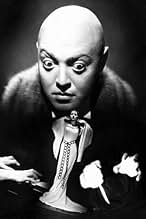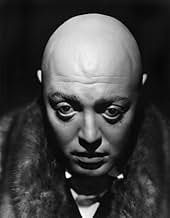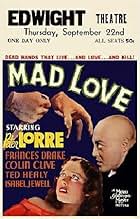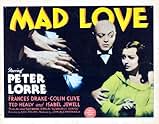Ajouter une intrigue dans votre langueIn Paris, a demented surgeon's obsession with a British actress leads him to secretly replace her concert-pianist husband's mangled hands with those of a guillotined murderer with a gift for... Tout lireIn Paris, a demented surgeon's obsession with a British actress leads him to secretly replace her concert-pianist husband's mangled hands with those of a guillotined murderer with a gift for knife-throwing.In Paris, a demented surgeon's obsession with a British actress leads him to secretly replace her concert-pianist husband's mangled hands with those of a guillotined murderer with a gift for knife-throwing.
- Réalisation
- Scénario
- Casting principal
- Récompenses
- 1 nomination au total
- Marie
- (as Sarah Haden)
- Chauffeur
- (scènes coupées)
- Undetermined Role
- (scènes coupées)
- Thief
- (scènes coupées)
- Marianne
- (scènes coupées)
- Undetermined Role
- (scènes coupées)
- Detective Arresting Stephen
- (non crédité)
- Train Conductor
- (non crédité)
- Stage Doorman
- (non crédité)
- Taxi Driver
- (non crédité)
Avis à la une
Loosely based on Maurice Renard's novel, "Les Mains d'Orlac" (literally, "The Hands of Orlac"), "Mad Love" is the story of Dr. Gogol (Peter Lorre), a brilliant surgeon deeply in love with a beautiful theater actress named Yvonne Orlac (Frances Drake). When season ends, Yvonne announces her retirement, and this prompts Gogol to finally meeting her. Unfortunately for Gogol, Yvonne tells him that she is actually married to concert pianist Stephen Orlac (Colin Clive). Saddened, Gogol leaves, but a bizarre turn of events will make him meet Yvonne one more time: Stephen has lost his hands in a terrible train accident and only Gogol's expertise will be able to save him. While he saves Stephen's hands, the operation begins to have serious side-effects, not only in Orlac, but also in Gogol.
While the screenplay was written by P.J. Wolfson, John L. Balderston and the usual assortment of contributing writers, the movie is mostly the work of Guy Endore and Florence Crewe-Jones, who made the adaptation from the French novel. Endore was a regular writer for MGM at the time, and helped to write other MGM's horrors like "Mark of the Vampire", "The Raven" and "The Devil-Doll"; it is his style, mix of Gothic and pulp novel what flows through the movie, although he remains true to the essence of Renard's classic horror novel. Renard is often credited as being the "inventor" of the Mad Scientist archetype, and truly gives a great use to it in his novel; appropriately, "Mad Love" keeps this psychological drama between characters and brings it to life, spending considerable time detailing the characters and their relationships, building up the necessary tension for the grandiose finale.
After directing several melodramas and comedies in a row, "Mad Love" allowed Freund to once again return to his expressionist roots and create a haunting tale of horror and madness in almost the same vein as his earlier classic, "The Mummy". Unlike what would be expected of a cinematographer, Freund dedicates as much attention to the non-visual aspects of the film as he does for the visual imagery, playing with the many different elements that form the bizarre love triangle of the film. The story itself focuses a lot in psychological themes, ranging from neurosis and hysteria, to compulsive obsession and dangerous psychosis; Freund makes great use of this themes across the movie, although it is obvious that he prefers the character of Dr. Gogol to the other protagonists of the film. Like Im-Ho-Tep the mummy, Dr. Gogol is driven by the mad love he feels for a woman, but unlike with the mummy, Freund makes sure to never fully transform Gogol into a monster, making him very human and frighteningly realist.
Peter Lorre's acting is essential for this last element in Gogol's persona, and he delivers one of this most amazing performances in his career. While lesser known than his characters in "M" or in "The Maltese Falcon", Dr. Gogol is certainly an iconic Lorre character that truly showcases Lorre's versatile talent. Frances Drake is surprisingly great, showing great emotion and excellent domain of the scene, giving her best to avoid being overshadowed by Lorre in their scenes together. Colin Clive, who would become famous as Dr. Victor Frankenstein in James Whale's films, delivers a truly effective performance as Orlac, but I found that Freund seems definitely much more interested in Dr. Gogol and his antics than in the pianist's neurosis, leaving few space to Orlac's growing insanity. Still, Clive does a very good performance despite the limited screen time his character receives when compared to Gogol.
It is probably this last point what truly stops this movie from being a classic of horror, as with a runtime of barely 68 minutes, it feels too short and gives the feeling that something was missing (perhaps a few more scenes with Colin Clive) in this psychological thriller. It's not really a big flaw in the end, but I truly was expecting to see the wonderful story being explored a bit more, as personally I felt it somewhat incomplete. On a different business, and as expected in a film by Karl Freund, the cinematography is simply brilliant, Chester A. Lyons and Freund's protegé, Gregg Toland (who would become a legend on his own), are in charge of it and devise one of the most beautifully looking horror of the 30s, easily on par with Freund's job for Universal.
It's a shame that studios were more interested in Freund's work as a cinematographer, because "Mad Love" proves that there he truly had talent as a director too. Who knows what would Freund had directed after this movie, specially considering the great improvements in cinematography he went on devising through his long and successful career. As it is, "Mad Love" is the final statement of a master who simply wasn't allowed to make more films (although who knows, probably he wasn't interested in directing), but it is nice to see him retiring with a top notch masterpiece. 9/10
At the request of Yvonne, Orlac grafts on a new pair of hands to Stephen. Unfortunately, they happen to be the hands of Rollo, an executed murderer who loved throwing knives. It seems the hands have a life of their own--Stephen can't play the piano anymore but can throw knives accurately and he has a desire to kill. He slowly starts to go crazy. Gogol again tells Yvonne that he loves her. She rejects him and Gogol cracks. He sets out to drive Stephen mad--and drive Yvonne into his arms.
The plot is silly but it still works. Anyways, the film isn't respected for its plot--it's because of Lorre and the sets. The sets in this film are huge, designed very strangely and add to the weirdness of the plot. They're all dimly lit giving the film a dark, depressing look. The acting is almost all good. Drake is just beautiful and perfect as the suffering wife. Clive is way too serious and looks horrible--sadly the man suffered from alcoholism...and it shows. Lorre is just superb as Gogol. He's very severe looking with his shaved head. You see him start out as kindly but obsessed and slowly slip into madness. Also there's a genuinely terrifying meeting Orlac has with Gogol (disguised as someone else) in a hotel. And director Karl Fruend throws in an amusing in joke--someone's repeats the "It went for a little walk" line from his "The Mummy" (1932)! The only real debit is the unnecessary "comic" relief from Ted Healy and an alcoholic landlady (sorry, but alcoholism isn't funny).
This is still mostly unknown more than 60 years after its release. Why? It bombed badly when it came out, was too grim for most people and it almost never pops up on TV. That's a shame--it's one of the best horror films to come out in the 1930s. See this if you get a chance--it's only 70 minutes and it's well worth it! One of Lorre's best performances.
"Mad Love" is the story of Doctor Gogol, brilliant Parisian surgeon whose reputation for doing surgeries on desperate cases free of charge is well- renowned. But Doctor Gogol is a morbid man as well, gleefully attending public beheadings and taking orgasmic delight in the Grand Guignol Theatre de Horreur, which stages realistic horror plays. The star of the Theatre is Yvonne, and Doctor Gogol is madly in love with her, hence the title of our film. But Yvonne is already married to Stephen Orlac, a famous concert pianist. Doctor Gogol, with his bald head and buggy eyes, gives her the creeps and her distaste for him is clear. However, when her husbands train crashes and his million-dollar hands are destroyed, it is Doctor Gogol she turns to. Desperate to win the love of Yvonne, Gogol agrees to do the impossible. Stephen Orlac is saved...but only Gogol knows that his hands are no longer his own. They once belonged to a killer, and they want to kill again.
Lorre turns in yet another astonishing performance here; his Gogol is very convincing, quite capable of handling a few lines of cornball dialogue without seeming foolish in the least. And the sympathy he elicits is simply amazing; I found myself cheering for him the whole time instead of for Yvonne, who struck me as a cold, opportunistic gold digger, quite willing to use the Doctor if it served her purpose. I'm sure this was not the intent of the filmmakers, but Lorre emerges as the hero here, at least in my humble opinion. Toward the end of the film, he is completely unleashed, playing mad, wild music on the organ and donning a most hideous metal contraption which looks like something that H. R. Giger might have designed.
This beautiful black-and-white film by MGM rivals the classic monsters of Universal, and placed Peter Lorre alongside such horror movie icons as Bela Lugosi, Boris Karloff and Vincent Price. Reportedly, Lorre detested these horror film roles that made him famous, but his resentment never shows through; he threw himself into this and every role with creativity and zeal. He is truly marvelous to watch. Mad Love should not be missed by fans of old, spooky Gothic tales. It is a masterpiece.
En route, Mr. Clive's hands are wounded in a train wreck. Called in to operate, Lorre decides to amputate Clive's hands and sew on the hands of a recently decapitated murderer. Poor Clive loses his piano-playing ability, but gains other talents The whole "hand transplant" machinations never grabbed me or aided in my suspension of disbelief; but "Mad Love" is stylish, has Karl Freund directing, and Lorre is an amazing sight for sore eyes. Also watch for the Yvonne's maid Sara Haden (as Marie), who can really hold her own.
******* Mad Love (7/12/35) Karl Freund ~ Peter Lorre, Frances Drake, Colin Clive, Ted Healy
Peter Lorre is great to watch! Even the most simple, corny line spoken by him rings with meaning and truthfulness, Lorre really knew how to play for/to the camera. This movie is only a little over an hour, highly recommended if you're going to do a double feature, and you're looking for a short feature as an appetizer.
Le saviez-vous
- AnecdotesCharles Chaplin called Lorre the screen's best actor after seeing his performance in "Mad Love."
- GaffesThroughout the picture, the wax figure moves slightly whenever Frances Drake is subbing for the actual statue. Most noticeable when the bird lands on her shoulder, making the "lifeless" statue sway.
- Citations
Françoise, Gogol's Housekeeper: [referring to the wax figure of Yvonne] It went out for a little walk!
- Crédits fousAt the end of the opening credits, the titles are painted on a glass window pane that is broken by a fist punching through it.
- Versions alternativesPhil Hardy's The Overlook Film Encyclopedia: Science Fiction (p. 94) states that there is an 85-minute version of the film, although he provides no details about this.
- ConnexionsEdited into The History of the Hands (2016)
Meilleurs choix
- How long is Mad Love?Alimenté par Alexa
Détails
- Date de sortie
- Pays d’origine
- Langue
- Aussi connu sous le nom de
- Mad love, les mains d'Orlac
- Lieux de tournage
- Société de production
- Voir plus de crédits d'entreprise sur IMDbPro
Box-office
- Budget
- 257 502 $US (estimé)
- Durée1 heure 8 minutes
- Couleur
- Rapport de forme
- 1.37 : 1






































